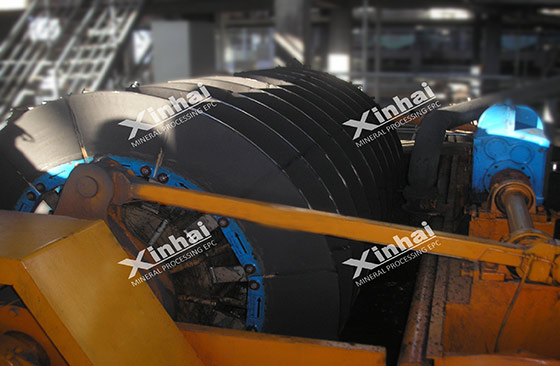
Bauxite is an important raw material resource for the alumina industry. With the over-exploitation of easy-to-select bauxite, it has gradually been depleted. At present, most of it is refractory bauxite, mostly iron-containing bauxite. Its iron-containing minerals are It exists in the form of hematite, goethite, limonite, etc., and aluminum exists in the form of gibbsite, boehmite and diaspore. Iron removal is required during the mineral processing process to obtain high-alumina concentrate.

Generally, the commonly used processes for separating iron from bauxite are gravity separation, magnetic separation, flotation, electric separation, flocculation and strong magnetic separation-anion reverse flotation. However, it is difficult to obtain better aluminum by this conventional mineral separation method. Soil concentrate. Aluminum and iron separation needs to be achieved through magnetizing roasting, direct reduction, Bayer, acid, reduction sintering or calcium aluminate slag smelting.
The conventional method takes magnetic separation as an example. The prerequisite for using magnetic separation to select aluminum and remove iron is that the aluminum and iron in the raw ore should be fully dissociated. For high-iron bauxite with simple mineral particle size, magnetic separation can be directly used. Through mineral processing and separation, ideal iron and aluminum concentrates can be obtained.
However, in high-speed iron bauxite, the particle size of iron minerals is relatively fine, and the symbiotic relationship between iron and aluminum minerals is complex. They are often closely embedded, and the iron and aluminum crystal structures are similar. A single magnetic separation method cannot effectively obtain qualified aluminum concentrate, and the composition loss is large.

The magnetization roasting method is used to select aluminum and remove iron. It mainly uses reducing gas (or coal) as a reducing agent to reduce the iron in bauxite into strong magnetite, and then uses magnetic separation to separate the magnet and bauxite. The process is to crush the raw ore to -5mm, add 25% coke amount, and conduct magnetization roasting at a roasting temperature of 780°C and a roasting time of 4.5 hours. After roasting, the minerals are ground and magnetically separated to obtain qualified iron ore concentrate and bauxite concentrate. However, this method suffers large losses and low recovery rate during the magnetic separation process.
The direct reduction method selects aluminum and removes iron. It also uses coal or gas as a reducing agent to reduce the iron in the ore into a strong magnet under solid conditions, and then uses magnetic separation to achieve effective separation of iron and bauxite.

However, the iron mineral particles in high-iron bauxite minerals are fine, and the metal magnets generated after direct reduction are difficult to polymerize. Therefore, the magnetic separation effect is poor, and it is ultimately difficult to obtain better aluminum-iron separation.
The Bayer method is used to separate aluminum and remove iron, which is suitable for processing gibbsite ore with a high aluminum-to-silicon ratio (A/S>7). The Bayer method is used to dissolve the ore to extract alumina, and then the iron is recovered from the red mud through mineral processing or acid dissolution. However, this method has high requirements for the quality of raw ore, and in high-speed iron gibbsite, Al2O3 not only exists in the form of gibbsite, but is sometimes mixed with diaspore and boehmite. Bayer method normal pressure leaching Only Al2O3 existing in the form of gibbsite can be dissolved, so the loss of Al2O3 in the raw ore is relatively large during the leaching process.
Aluminum selection and iron removal by acid method utilizes the different abilities of iron and aluminum to dissolve in acid under different conditions, and uses the sequence of evaporation and crystallization of iron and aluminum salt solutions to separate iron and aluminum salt crystals, and then thermally decomposes them to obtain oxidized Aluminum and iron oxide.
Since most silicon compounds are insoluble during the acid dissolution process, iron and aluminum react with acid and dissolve in the liquid, so the acid method is suitable for processing high-silica bauxite. However, the acid method causes serious environmental pollution, it is difficult to recover and recycle the acid liquid, and it requires high equipment.
The reduction sintering method is used to select aluminum and remove iron. It uses the traditional sintering method to produce alumina, and then adds sodium carbonate, calcium carbonate and coal powder to the high-iron and high-silicon bauxite for sintering, so that the bauxite reacts with the sodium carbonate to generate solid aluminum. Sodium acid, silicon minerals react with high-temperature decomposed calcium oxide to form calcium silicate, while iron minerals are reduced to magnetite or metallic iron.

The calcium aluminate slag smelting method is used to select aluminum and remove iron. Limestone (or quicklime) and coal are added to the high-speed iron bauxite ore, and then reduced in a semi-molten or molten state in high-temperature equipment such as a rotary kiln, blast furnace or electric furnace. , sintering or smelting, reducing iron minerals to solid metallic iron or molten iron or alloy iron, and slagging aluminum minerals and lime to produce calcium aluminate slag. The final separation of aluminum and iron can be achieved by separation of slag iron from molten iron and calcium aluminate slag, or by magnetic separation of iron particles.
However, the calcium aluminate slag smelting method requires high smelting temperature, large lime consumption, large slag volume and low alumina leaching rate.
The above is an introduction to conventional methods and other iron removal methods for bauxite separation. In the actual mineral processing plant, it is necessary to analyze the aluminum and iron components in the bauxite and the mineralization conditions, and then design a suitable method according to the test conditions. High-speed rail bauxite beneficiation and iron removal process plan.
To find out more about our products and solutions, please fill out the form below and one of our experts will get back to you shortly.